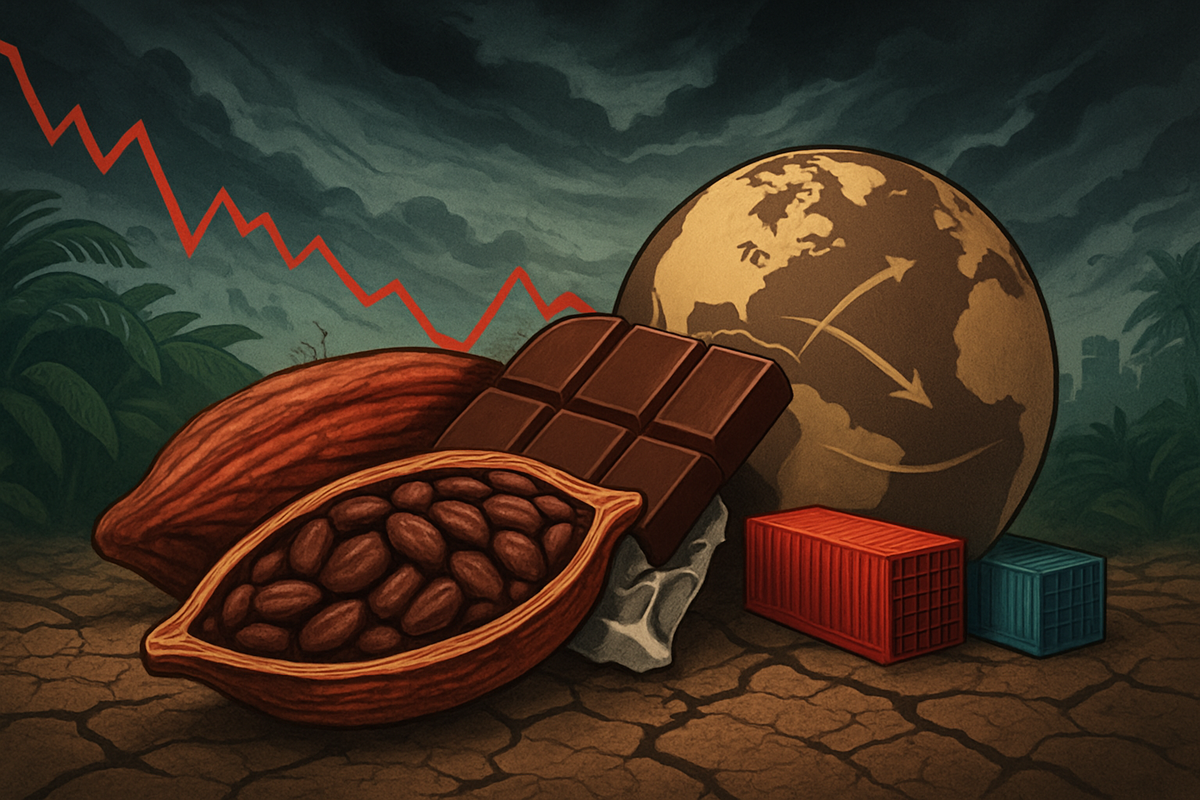
October 27, 2025 – The global cocoa market is currently embroiled in an unprecedented maelstrom of trade chaos, sending prices on a wild rollercoaster ride and inflicting profound impacts on chocolate makers worldwide, from multinational giants to artisanal Pacific producers. This turbulent environment, characterized by geopolitical tensions, climate-induced supply shocks, and evolving trade regulations, has fundamentally reshaped the landscape for one of the world's most beloved commodities.
As of October 2025, cocoa prices, while having retreated from their late 2024 and early 2025 peaks of nearly $13,000 per metric ton, still hover around $6,116.57 USD/T, significantly higher than historical averages. This persistent elevation signals a "new normal" for the industry, where the sweet indulgence of chocolate now carries the bitter taste of complex supply chain vulnerabilities and escalating costs. The ripple effects are already evident, with consumers facing higher prices and manufacturers grappling with the delicate balance of maintaining profitability and product integrity.
The Perfect Storm: Unraveling the Cocoa Market's Distress
The current turmoil in the cocoa market is the culmination of a "perfect storm" of interconnected crises that have severely constrained supply and disrupted global trade routes.
The primary driver of the severe supply shortages originates from West Africa, specifically Côte d'Ivoire and Ghana, which collectively account for over 70% of the world's cocoa. Since 2019, these regions have been battered by adverse weather conditions, including El Niño-induced droughts, erratic rainfall, and excessive heat, which have devastated crops. Compounding this, the insidious Cocoa Swollen Shoot Virus (CSSV) continues to decimate vast swathes of cocoa farms, with estimates suggesting up to 30% of farms in Côte d'Ivoire are infected. Many existing cocoa trees are also aging and less productive, further exacerbating the yield crisis, while low farmer incomes have stifled investment in replanting and sustainable practices. Early arrivals at Ivorian ports in October 2025 were notably lower than the previous year, signaling ongoing supply constraints for the 2025/2026 season.
Beyond farm-level issues, global trade chaos has amplified the crisis. Persistent geopolitical conflicts, such as the Red Sea crisis, continue to force shipping companies to reroute vessels around the Cape of Good Hope, leading to extended transit times and dramatically increased freight and insurance costs. While the Panama Canal saw some recovery in transit capacity in fiscal year 2025 after severe 2024 drought restrictions, the long-term threat of climate-induced water scarcity remains. These logistical bottlenecks add layers of expense and uncertainty to the movement of cocoa beans from producing regions, including the Pacific, to processing hubs.
Initial market reactions have been characterized by unprecedented price volatility. Cocoa futures soared to all-time highs in late 2024 and early 2025, before a significant correction by August 2025, driven partly by "demand destruction" as manufacturers struggled with soaring input costs. However, prices remain remarkably elevated compared to the decade-long average of $2,000-$4,000 per metric ton. Major chocolate companies have responded by raising consumer prices, implementing "shrinkflation" (reducing product size), and exploring product reformulation to use less cocoa or alternative ingredients. Cocoa grindings—a key indicator of industrial demand—declined significantly in Europe, Asia, and North America in Q2 and Q3 2025, reflecting the industry's struggle to absorb the higher costs. Key players and stakeholders, from smallholder farmers to multinational corporations like Nestlé S.A. (NESN: SWX) and Mars, Incorporated, are all grappling with this new reality. Cocoa traders such as Olam Food Ingredients (ofi) and Barry Callebaut AG (BARN: SWX) face immense pressure to secure supply amidst fierce competition and escalating costs.
Who Wins and Who Loses in the Cocoa Crunch
The current market volatility creates a clear divide among companies, with some better positioned to weather the storm than others.
International Chocolate Makers: Navigating a Costly Landscape
Mass-market chocolate producers are among the hardest hit. Companies like Hershey (HSY: NASDAQ) have already informed retail partners of "price packaging structures" adjustments, effectively reducing product sizes, a practice often dubbed "shrinkflation." Hershey also reported a 26.6% decline in its confectionery segment value in Q1 2025 due to lower sales volumes and rising production costs. Similarly, Mondelēz International (MDLZ: NASDAQ) warned that cocoa prices would heavily impact its 2025 performance, with North American chocolate candy sales volume declining over 21% in the 13 weeks ending September 7, 2025. These companies, along with bulk cocoa processors like Barry Callebaut AG (BARN: SWX), which revised its 2025 production outlook for a mid-single-digit sales volume drop, are facing intense pressure on profitability and are forced to reformulate products, potentially risking a "milder chocolate flavor" for consumers. Smaller premium players without strong brand recognition or robust hedging strategies, such as Lir Chocolates in Ireland, which saw pretax profits plummet by 85% in 2024, are also struggling to absorb costs and pass them on to consumers.
Conversely, premium brands with strong pricing power and innovative strategies are proving more resilient. Lindt & Sprüngli AG (LISN: SWX), for example, has seen its stock rise by 28% in 2025, demonstrating its ability to pass on higher costs to customers, partly through launching "crowd-drawing products." Companies diversifying their product portfolios or exploring cocoa alternatives are also finding new pathways. A UK company, Win-Win, is pioneering cocoa-free chocolate made from fermented cereals and legumes, attracting significant interest as a hedge against volatility. Additionally, some confectionery companies are boosting gummy production and cutting chocolate output, responding to shifting consumer preferences and aiming to maintain profit margins. Larger international players with robust hedging strategies and diversified supply chains, though still challenged, are better equipped to manage the extreme price fluctuations.
Local Pacific Cocoa Producers/Processors: Opportunities and Obstacles
The Pacific region, encompassing nations like Papua New Guinea, Solomon Islands, Vanuatu, and Fiji, known for its high-quality, often fine-flavor cacao, faces a mixed bag of opportunities and obstacles.
Producers of specialty and fine-flavor cocoa are potential winners. The growing global demand for single-origin and artisanal chocolates allows these Pacific producers to command premium prices and engage in direct trade relationships, bypassing some of the volatility of the bulk market. Continued investment in quality control and certifications (e.g., organic, fair trade) is crucial for differentiation. Furthermore, local processors investing in value addition, by converting beans into cocoa liquor, butter, or powder within the region, can capture a larger share of the profit margin, reducing dependence on raw bean exports. If Pacific nations follow the lead of West African governments, which have significantly raised farm-gate prices (e.g., Ghana by 12% for 2025/26, Côte d'Ivoire by 55.6%) to support farmers, local smallholders could see improved earnings, though inflation and currency depreciation can erode these benefits.
However, many Pacific smallholder farmers, who often lack direct market access or are tied into unfavorable contracts with intermediaries, may not fully benefit from the elevated global prices. They struggle with rising input costs and limited access to financing. A significant challenge is the European Union Deforestation Regulation (EUDR), set to take effect for major businesses by December 2025. This regulation mandates stringent due diligence to prove that cocoa does not originate from deforested land. Smaller Pacific producers may struggle with the increased scrutiny, technological hurdles, and costs of establishing robust traceability systems, potentially hindering access to the lucrative European market. Climate change also poses a persistent threat, with altered rainfall patterns, droughts, and increased disease prevalence impacting yields, similar to the challenges in West Africa.
Broader Implications: A Reshaped Industry Landscape
The current cocoa crisis transcends immediate price fluctuations, signaling profound shifts in broader industry trends, regulatory frameworks, and the very fabric of global food supply chains.
The event powerfully underscores the urgent need for enhanced sustainability and supply chain resilience. The heavy reliance on a concentrated supply from West Africa has proven to be a critical vulnerability. This crisis is accelerating efforts by companies to diversify sourcing to regions like Latin America (Ecuador, Brazil) and Asia (Indonesia), and to invest heavily in climate-smart agriculture, disease-resistant cocoa strains, and robust traceability systems, often utilizing blockchain technology. The long-standing issues of farmer poverty and child labor are being brought into sharper focus, with increased pressure on the industry to ensure a living income for farmers, as their financial instability often drives unsustainable practices like deforestation.
The ripple effects extend across the entire food industry. Beyond chocolate and confectionery, sectors using cocoa derivatives in bakery, dairy, and beverages will face increased ingredient costs. Retailers must manage higher product prices and potential stock shortages. For consumers, the era of readily affordable chocolate may be fading, replaced by more expensive, smaller, or reformulated products. The crisis is also fostering innovation, with the development of cocoa-free alternatives gaining traction, potentially leading to a diversification of the "chocolate" category itself.
Regulatory and policy implications are expanding beyond the EUDR. While the EUDR is a pivotal force in demanding deforestation-free cocoa, there's growing international emphasis on living income initiatives for cocoa farmers. Governments in producing countries are actively raising farmgate prices to support farmers and curb smuggling, though the effectiveness in translating to actual living incomes remains a challenge. There's also a global push for targeted climate finance to help cocoa growers adapt to changing conditions and for investment in research for disease-resistant varieties. Central banks are even beginning to factor climate change into their policy considerations, acknowledging its impact on commodity-driven inflation.
Historically, such extreme commodity price volatility is not unprecedented. The magnitude of recent price surges in soft commodities, including cocoa, draws comparisons to periods like 1971-74 and 1994-96, which also saw rapid increases driven by strong global demand, supply shocks, and currency depreciation. The 1970s, in particular, saw similar levels of nominal price volatility. These historical precedents highlight that while market adjustments eventually occur, the current environment is uniquely complex due to the confluence of pervasive climate change, entrenched geopolitical factors, and accelerating regulatory demands.
What Comes Next: Navigating a Transformed Market
The future of the global cocoa market presents a landscape of both persistent challenges and emerging opportunities, demanding strategic pivots from all stakeholders.
In the short-term (next 1-3 years), cocoa prices are expected to remain volatile but stabilize at levels significantly higher than historical averages. While the International Cocoa Organization (ICCO) surprisingly forecasted a 142,000 MT surplus for the 2024/25 season, many analysts remain cautious due to ongoing structural issues in West Africa. The full implementation of the EUDR in December 2025 will be a critical factor, potentially restricting supply from non-compliant regions and adding compliance costs. Chocolate manufacturers will continue to engage in "skimpflation" (reducing cocoa content) and product reformulation to manage costs.
The long-term (beyond 2027) outlook projects significant growth for the global cocoa bean market, estimated to reach $20.8 billion by 2032, driven by rising disposable incomes and evolving lifestyles in emerging markets, particularly the Asia-Pacific region. Beyond traditional confectionery, cocoa's use in bakery, dairy, beverages, nutraceuticals, and cosmetics is expanding. However, this growth will be tempered by persistent challenges: the ongoing threat of climate change and diseases, farmer poverty, supply chain concentration, and the high costs of meeting stringent new regulations. There is also a long-term risk of oversupply and sharp price corrections if widespread new plantings and alternative origins mature simultaneously.
Strategic pivots are essential across the board. Cocoa farmers must adopt sustainable agroforestry, climate-smart agriculture, and disease-resistant varieties, while also diversifying crops and engaging in fairtrade initiatives to secure better incomes. Cocoa processors and chocolate manufacturers must diversify sourcing beyond West Africa, invest in robust traceability systems to comply with regulations like EUDR, and innovate with product reformulation or cocoa-free alternatives. Governments and regulatory bodies need to provide climate finance and adaptation support to producing countries, enforce fair pricing mechanisms, and invest in rural infrastructure to improve market access for farmers.
Emerging market opportunities include the rise of new sourcing origins in Latin America and Asia, growing demand for premium and artisanal chocolate, the expansion of health and wellness cocoa products, and significant innovation in cocoa-free alternatives and byproduct upcycling. However, persistent challenges remain: the relentless impacts of climate change, the spread of pests and diseases like CSSV, pervasive farmer poverty, and the high costs of meeting stringent new regulations.
Potential scenarios and outcomes include:
- "Climate Crisis & Sustained High Prices": Severe climate events and disease lead to persistent deficits, making cocoa a luxury commodity and accelerating the shift to cocoa-free alternatives.
- "Adaptation & Diversification" (Most Likely Short-to-Medium Term): Significant investments in sustainable practices and diversified supply lead to more distributed supply, stable but elevated prices, and a mix of traditional and innovative chocolate products.
- "Technological Transformation" (Long-Term): Lab-grown cocoa and fermentation-based alternatives scale commercially, potentially decoupling chocolate prices from agricultural cocoa volatility.
- "Global Economic Slowdown & Demand Contraction": A severe economic downturn could temporarily moderate prices even with constrained supply, as consumer spending on discretionary items like chocolate declines.
Wrap-Up: A New Era for Chocolate
The global cocoa trade chaos of 2025 marks a definitive turning point for the industry. It underscores an undeniable truth: the era of cheap, abundant cocoa is likely over. The confluence of climate change, disease, and geopolitical instability has fundamentally recalibrated the value proposition of this critical commodity.
Key takeaways include the stark vulnerability of a concentrated supply chain, the establishment of a new, elevated price floor for cocoa, and an accelerated drive towards innovation in product alternatives and sustainable sourcing. The crisis has illuminated the urgent need for a more equitable and resilient global food system.
Moving forward, while some signs of supply recovery are emerging, particularly for the 2025/2026 season, the market will remain complex and volatile. Long-term growth is projected, driven by increasing global demand, but it will be constrained by persistent productivity challenges in West Africa and the costs associated with sustainable practices and regulatory compliance. The industry is poised for significant transformation, with a focus on diversified sourcing, technological innovation, and a deeper commitment to ethical and sustainable practices.
For investors, vigilance is key in the coming months. Watch for:
- Cocoa Prices: While recent declines offer some relief, monitor for renewed volatility or stabilization around the $6,000/tonne mark, as structural issues persist.
- West African Output: Closely track official port arrival data from Côte d'Ivoire and Ghana for the 2025/2026 main crop.
- Weather Patterns: Keep an eye on La Niña forecasts for late 2025 and its potential impact on South American cocoa-producing regions.
- EUDR Enforcement: Observe the practical implementation and enforcement of the EU Deforestation Regulation from December 2025, as it will directly affect market access and supply dynamics.
- Company Strategies: Analyze earnings reports of major confectionery companies like Hershey (HSY: NASDAQ), Mondelēz International (MDLZ: NASDAQ), and Nestlé S.A. (NESN: SWX) for impacts on profit margins, sales volumes, and their strategic pivots towards diversified sourcing, product innovation (including cocoa-free alternatives), and robust hedging. Also, monitor the strategies of key traders and processors like Barry Callebaut AG (BARN: SWX).
The lasting impact of this period will be a more expensive, but hopefully more sustainable and transparent, chocolate industry. Adaptability, diversification, and a strong commitment to sustainable practices will be paramount for all stakeholders to thrive in this transformed landscape.
This content is intended for informational purposes only and is not financial advice






